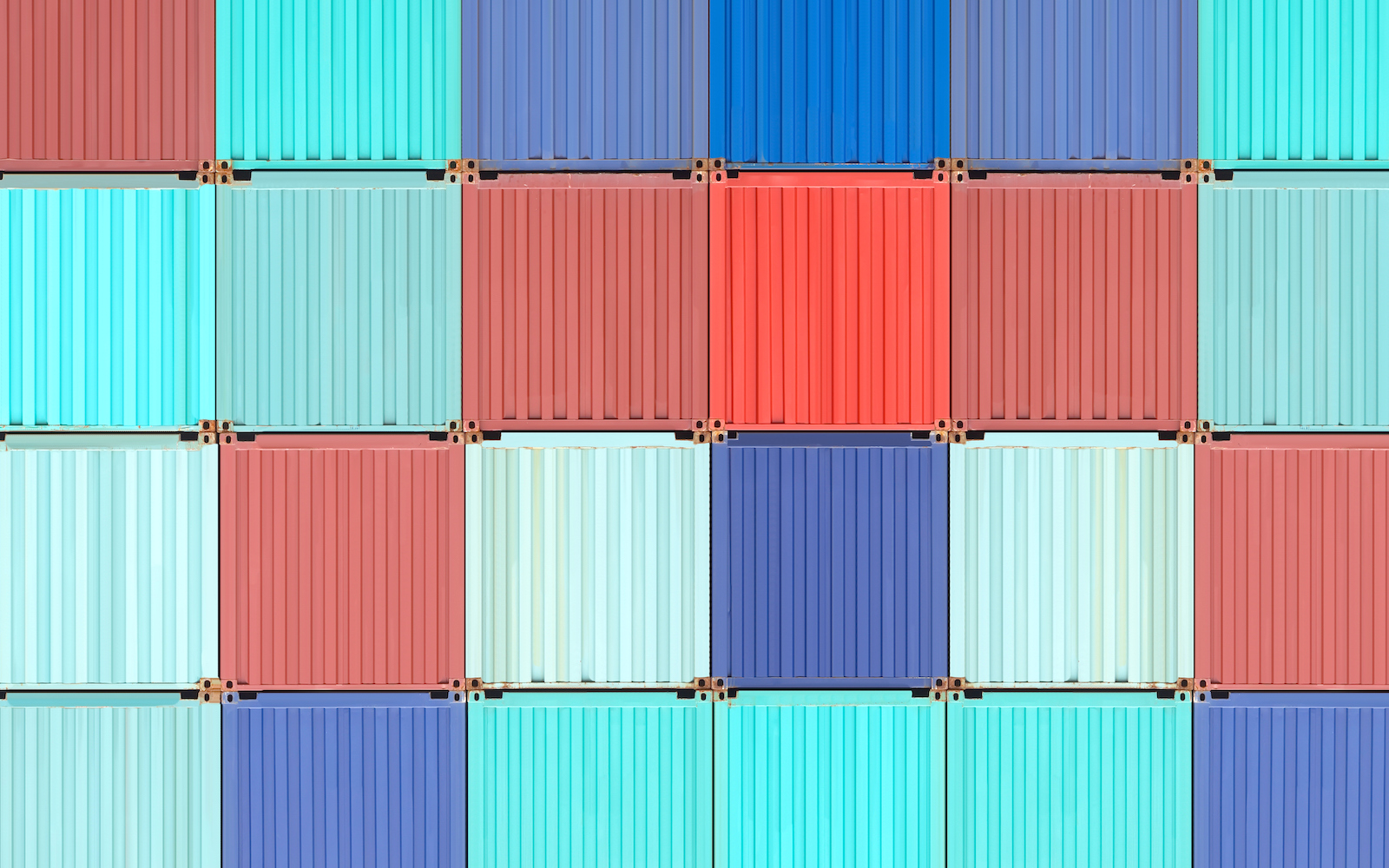Table of Contents
** Minutes
The benefits of freight shipping
How to get (and calculate) freight shipping quotes
How to select a freight shipping company
How to prepare a freight shipment
How does freight apply to ecommerce order fulfillment?
Freight is the transportation of goods in bulk via road, intermodal transport (rail and road), ship, or air. Freight shipping is an integral part of many ecommerce businesses’ operations, especially when international shipping is involved.
In this article, we’ll cover what classifies as freight, break down the different freight shipping methods, walk through how freight shipping works, and more.
What is freight?
Freight (also called “freight shipments”) refers to goods or products that are transported in bulk.
While the term can mean different things to different entities, freight almost always describes large quantities of products that are transported together, and that are collectively much bigger and/or heavier than a regular parcel shipment.
In rarer cases, a single item may be so heavy that it requires the equipment used to transport freight shipments, but these are exceptions.
What is freight shipping?
Freight shipping is the transportation of large shipments of goods domestically or across the globe via air, land, or sea. The goods are loaded on pallets or into large, sturdy containers and transported using one or more modes of transportation.
What classifies as a freight shipment?
Any shipment that is larger than 30 inches by 30 inches by 30 inches, or weighs over 150 pounds is considered freight. Shipments under these dimensions would typically be more cost-effective to ship via parcel.
Freight delivery shipments can either be loaded onto a truck on pallets or floor-loaded. Floor-loaded trucks need to be unloaded by hand, while inventory loaded on pallets can be easily loaded/unloaded using a dock or forklift.
A standard truck can transport a maximum of 26 pallets. The typical dimension of a pallet is 48 inches wide by 40 inches long, with a maximum height of 80 inches. Any pallet exceeding 48 inches in height is considered a double-stacked pallet.
Truck beds and containers are typically four feet off the ground. In order to load/unload the truck, warehouses are equipped with an elevated dock.
- If the warehousing and storage facility isn’t equipped with a dock, an alternate solution is to load/unload the truck by using a forklift or loading equipment.
- If any pickup/drop-off location does not have a dock or forklift, a truck with a lift gate service can be booked for an additional cost.
The state of freight in 2023
The state of freight in 2023
At first glance, the freight industry seems to be slowly but surely returning to pre-pandemic norms. Ocean freight prices have been dropping steadily, with some route rates falling as much as 80% since April of 2022. Congestion at major ports like LA/Long Beach and NY/NJ is also improving.
But before merchants rejoice, it’s important to consider the macroeconomic factors behind these changes. Rising inflation has led to a drop in consumer spending, which in turn has caused freight volumes to drop. At the same time, geopolitical conflicts in Europe caused oil and gas prices to skyrocket, forcing many freight providers to pass fuel surcharges along to their customers (which, if persistent, could further contribute to declining freight volumes).
While these factors may not signal a full freight recession in 2023, merchants should be cautious and continue to brace themselves for further freight challenges. With still more factors yet to influence freight volumes and prices in 2023 (such as new COVID variants or labor shortages), freight providers should prepare to operate in an ever-changing landscape, and buckle down for the challenges ahead.
The benefits of freight shipping
Don’t let the complexities of freight shipping prevent you from leveraging its benefits. Here are just a few of the advantages of shipping freight.
Cheaper transport & shipping costs
Even if the cost of freight shipping initially gives you sticker shock, it’s usually more cost-effective than shipping items in smaller batches through the regular postal service. This is especially true when using ground freight modes like trucking, and for freight traveling within a single country.
Greater efficiency
Typically, transporting a large quantity of your inventory from one place to another in a single trip is quicker and simpler than making multiple smaller trips.
While freight’s efficiency depends on the industry’s state — as supply chain disruptors like the pandemic caused unprecedented delays and stagnant containers — if the market is balanced, freight is usually the fastest way to transport a lot of inventory.
Better restocking
It doesn’t make sense for a merchant to constantly be reordering small quantities of inventory — not only is it not a good use of time, but it leaves your business vulnerable to stockouts if demand surges unexpectedly.
Freight shipments help a business stay stocked for longer periods of time, making it easier to manage inventory and meet customer demand.
How to get (and calculate) freight shipping quotes
Before committing to a freight shipping partner, you’ll want to request and compare quotes from multiple freight service providers. Different companies may request different information in order to give you an accurate quote, but in general, be prepared to provide the following information:
- Company name
- Contact information (email/phone/business address)
- Cargo ready-by date
- Supplier/origin address
- Destination address
- Shipment mode (ground/air/ocean/etc.)
- Type of package (pallets, boxes, or crates)
- Dimensions of the shipment (length, width, height)
- Weight of shipment in kilograms and pounds
- Number of containers
- Value of the shipment
Quotes are influenced by a variety of factors, including the mode of transportation, shipping distance, a shipment’s size and weight, and others. Precise quotes will vary from company to company — but in general, the larger and heavier the shipment, the farther it’s traveling, and the more complicated it is to ship, the more expensive it will be.
Freight prices are extremely volatile, with some of the highest quotes we’ve seen since the onset of the pandemic. For example, this snapshot below from Freightos’ index shows how much quotes changed over a 3-month period from for a China/East Asia to North America West Coast route (going from USD $15,764 in mid-April 2022 to USD $7,409 in mid-July 2022).
There are dozens of freight providers out there, but there are a few that stand out from their competition. Here is our list of top freight providers, and approximate quotes.
Note: Freight shipping quotes are often volatile, and can even change from day to day. As such, we recommend that you reach out to each provider for a timely quote.
Calculate freight shipping costs
Freight shipping costs can vary widely depending on the freight provider you partner with.
The easiest way to estimate your freight shipping costs is to get a quote from a few different carriers that offer the freight services you’re looking for. This process usually involves inputting information about the products you’re shipping, the shipment’s origin point and destination, and any special handling instructions or value-added services.
Once you have quotes from a few carriers, you can compare prices and services to determine the best fit for your freight needs.
Here are some common freight carriers ecommerce businesses use, and a little more information about their freight services to help get you started.
Fedex
Fedex considers any shipment over 150 lbs to be freight, and even offers a multiweight logic program to help you determine whether it’s more cost-efficient to send one freight shipment or multiple parcel shipments.
While FedEx specializes shipping domestic LTL freight, it also provides express and international, air, and ocean freight options. You can get a quote online by using their online pricing tool.
UPS
As a competitor to Fedex, UPS is a freight forwarder that offers many of the same freight services, including air, ocean, ground, multimodal, and express freight. UPS also provides value added services like customs brokerage, freight tracking, and supplier management.
You can use their online calculator to receive a time and cost quote for your freight shipment.
uShip
uShip connects individuals or businesses with freight carriers, and provides quotes from a variety of carriers on a job-by-job basis, one of which the shipper can choose and book. The platform specializes in arranging LTL freight services, as well as vehicles and heavy equipment.
You can browse similar listings to get a sense of what your freight needs might cost, or sign up to list your shipment and receive actual quotes.
A-1 Auto Transport
A-1 Auto Transport specializes in a variety of transportation services, including domestic and international auto transport, door-to-door car shipping, classic car transport, motorcycle shipping, boat and watercraft transport, RV and motorhome transport, and freight shipping. With a focus on providing reliable and efficient transportation solutions, A1 Auto Transport caters to customers’ diverse needs, ensuring the safe and timely delivery of vehicles and other goods to their destinations.
FreightBob
FreightBob is ShipBob’s end-to-end managed freight solution, powered by Flexport. This program combines ShipBob’s cross-docking, inventory distribution, and fulfillment network to coordinate freight shipments for ecommerce merchants and achieve faster shipping times and lower costs when shipping inventory from China to the US.
Learn more about FreightBob and ShipBob’s fulfillment solutions by clicking here.
5 freight shipping methods
There are five types of freight shipping methods to choose from: full truckload (FTL), less-than-truckload (LTL), partial truckload (PTL), intermodal, and expedited. Below explains the differences of each:
1. Full truckload (FTL)
A full container is available for transporting inventory. Full truckload freight shipments can be moved via road or rail. Most FTL containers can transport 24 to 26 pallets. FTL shipments are direct shipments from the pickup location to the destination (e.g., from the manufacturer to a fulfillment center).
2. Less-than-truckload (LTL)
A less-than-truckload (LTL) shipment is between 1 and 6 pallets. LTL freight shipments are the most common method used. In LTL freight shipping, ecommerce inventory is often transferred onto different trucks on the way to its destination.
3. Partial truckload (PTL)
A partial truckload (PTL) shipment is between 6 and 12 pallets. For PTL shipments, once the inventory is loaded onto the truck, the possibility that the inventory will be transferred to a different truck during the journey is low.


4. Intermodal
Intermodal typically involves the combination of rail and truck, but it can also be a variety of rail, trucks, and ships. One of the benefits of involving rail as part of your freight shipping method is it can reduce fuel use and lower shipping costs.
5. Expedited
Expedited freight is used for time-critical shipments and often involves truck and air. Out of all the freight shipping methods available, expedited is the most expensive.
How to select a freight shipping company
While pricing is important, there are many other facts you should also consider when choosing a freight service provider. Depending on what you’re shipping, you may require particular services or features in your freight shipping solution. Checking to make sure a provider and provide these services or accommodate your needs before signing on will save you time and cost down the road, and greatly simplify the freight process.
Consider the following factors when assessing various freight partners:
- Transportation — What mode of freight transportation will you be using? Will you utilize more than one mode? Choose a freight partner that specializes in the modes of transport that you’ll rely on most.
- Origins and destinations — Where will you be shipping to and from most often? Selecting a partner that can easily and affordably ship to and from your locations. Double-check that your partner is capable of handling international freight shipments if you need to bring inventory in from or send it overseas.
- Special handling — Certain products (such as HAZMAT items or perishables) will incur additional fees and charges to ship, and may have unusual delivery requirements. Make sure that your freight provider is aware of any and all specifications, and that they have the correct procedures in place.
- Technology — To avoid partnering with a freight provider that has clunky or outdated technology or operating procedures, ask potential partners about their software’s capabilities.
| Freight Shipping Provider | Core Offerings | Quote |
| Flexport | A freight-forwarding service offering a web-based app that provides real-time visibility. Services include: – Multimodal shipping (air, ocean, & trucking) – Warehouse & fulfillment – Customs brokerageCargo insurance | Request a Quote |
| Freightos | A digital booking platform for international shipping. Services include: – Real-time quote comparison between air freight, ocean freight and trucking freight providers – Interface for live updates and shipment tracking | Request a Quote |
| Echo Global Logistics | A 3PL specializing in transportation management for freight shipments. Services include: – Multimodal shipping (air, ocean, & trucking) – A proprietary, web-based technology platform that compiles and analyzes data across a network of transportation providers | Request a Quote |
| Matson | A transportation services company specializing in ocean freight. Services include: – Pacific shipping, servicing Hawaii, Alaska, Guam, Micronesia and the South Pacific Terminal and steredoving services at 8 terminal facilities on the U.S. West Coast – Truckload, intermodal, and LTL logistics services across the U.S. | Request a Quote |
| ZIM Integrated Shipping Services | Freight provider specializing in cargo shipping with a digital portal. Services include: – Freight shipping lines to and from the Americas, Caribbean, Mediterranean, Europe, Middle East, and Africa – An online dashboard through which customers can monitor import and export shipments and receive documentation, notifications, and more | Request a Quote |
| Maersk | Integrated logistics and transport provider. Services include: – Ocean, air, inland, and intercontinental rail freight – Supply chain and logistics services, including warehousing and distribution | Request a Quote |
How to prepare a freight shipment
Freight shipping preparations are different from a typical parcel shipment. Here are a few key tips to help ensure your freight shipment is shipped, handled, and received as securely and accurately as possible.
Prepare appropriately sized pallets
Pallets are used to consolidate shipments and allow for ease of movement. A high-quality pallet is made of either wood or plastic and should weigh between 20 and 70 pounds. When choosing the right pallet, make sure it’s sturdy enough to support the load and large enough to avoid overhang, which can cause damage.
Design non-palletized shipments
If you’re not using a pallet, prepare appropriate shipping containers, crates, or corrugated boxes, and make sure they are strong enough to support the weight of the package. If you’re reusing containers, remove old shipping barcodes and labels to lower the risk of goods being shipped to the wrong location. Many top carriers recommend that you avoid reusing boxes for freight shipping, but if you do, check for any holes or tears before using.
Use dunnage on all sides of the container to keep items in place and reinforce edges to protect from bending. Seal all openings and seams closed with reinforced tape.
Attach the necessary labels
Depending on the details of your shipment, you will need to affix various labels and documentation to pallets before you send them.
Standard freight pallets should have visible labeling with a telephone number and the shipper’s address on each side of the pallet, as well as a packing list and bill of landing (BOL). For international freight, you will also need a commercial invoice and certificate of origin (although these are often sent electronically).
If you partner with a 3PL, your partner may also have specific labeling requirements for freight. ShipBob, for example, requires customer to follow a WRO process and attach the WRO to the shipment (or, if crossdocking, attach one WRO for the crossdock location and another for the end destination).
Follow freight carrier instructions
Every freight carrier will have their own set of instructions on how to prepare for pickup. Some shipment pickups do require pre-authorization. Be sure to read through your freight carrier’s instructions thoroughly for a stress-free pickup.
How does freight apply to ecommerce order fulfillment?
When working with a 3PL for order fulfillment, ecommerce businesses use freight shipping to send inventory to the 3PL’s fulfillment centers. Many logistic service providers help their clients book freight shipments with external providers, as well as walk them through the necessary shipping and receiving processes as well as freight shipping rates to ensure that inventory arrives at the fulfillment center safe and sound.
ShipBob, for example, partners with ecommerce businesses of all sizes seeking to outsource their inventory receiving and storage, as well as their order fulfillment and shipping logistics. With ShipBob’s help, you can arrange your freight shipment and distribute your inventory across dozens of ShipBob fulfillment centers, where ShipBob’s warehouse teams will handle picking, packing, and shipping your DTC and B2B orders for you.
How ShipBob helps ecommerce businesses manage their freight
If you find yourself struggling to navigate the complexities of freight (especially in the current supply chain crisis), ShipBob can help. Through integrations with major freight service providers, ShipBob facilitates a smoother freight shipping and inventory receiving process for ecommerce businesses while lowering cost.
Specifically, ShipBob’s managed freight program FreightBob is designed to help you sidestep port congestion and supply chain blockages, reduce time-in-transit, and distribute your inventory more strategically.
Powered by Flexport, this program sees inventory loaded onto guaranteed weekly sailings from China to cut transit time to 15-30 days, keeping your freight shipments predictable, and your customers happy. Dedicated containers for ShipBob merchants and priority dock space at ShipBob’s fulfillment centers enable you to stock inventory faster, and we’ll even help you distribute your inventory strategically across the US.
If you’re interested in learning more about FreightBob, click below to talk to an expert.
Freight Shipping FAQs
There are a few things to keep in mind before you start shipping products via freight. Here are some answers to common questions.
What is a bill of lading?
A bill of lading a document that is issued by the carrier. It acknowledges receipt of cargo for shipping. It was once only related to shipping by sea, but a bill of lading may also be used for other freight shipping methods as well.
What can be shipped via freight?
Just about anything, but it’s important to check with your carriers first as some rules for certain types of products may apply. Certain freight shipping providers have limitations on items that are high in value (e.g., fur, watches, jewelry), dangerous or hazardous (e.g., aerosols, fireworks), too large (e.g. canoes), or temperature-sensitive (e.g., frozen foods).
What’s the difference between parcel and freight?
Parcel shipping refers to small, lightweight and individual shipments typically handled by common carriers. Most parcel shipments are limited to 150 pounds. Freight shipping is a great option for shipping heavy items, especially when transporting long distances.
For ecommerce brands, shipping inventory in bulk from a manufacturer to a fulfillment center is often done with freight shipping. Once in the fulfillment center, direct-to-consumer orders are often sent with parcel shipping. If sending inventory to another retailer, B2B ecommerce or wholesale shipments may be done via parcel or freight shipping depending on the size of items and quantity of units.
What is freight classification?
Freight classification is a standardized method designed by the National Motor Freight Classification (NMFC) to give consumers and carriers a uniform pricing structure when shipping freight. It measures an item’s transportability by density, stowability, liability, and ease of handling. Class numbers are between 50 and 500.
How much does it cost to ship freight?
It depends on several factors, including:
- Weight
- Dimensions
- Type of packaging
- Mode of transportation
- Time-sensitivity
- Freight class
- Distance between shipment’s origin and destination



